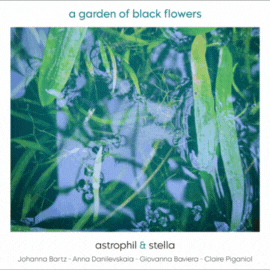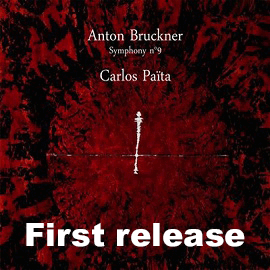Die Komponistin Emilie Maria Baronin von Bach wurde noch im vorletzten Jahrhundert geboren und erlebte dann mehr als acht Jahrzehnte. Aus gutsituiertem Hause stammend lernte sie schon früh gesellige Salons mit großen Künstlern kennen, wo Julius Korngold ihr Talent wahrnahm. Bei Joseph Marx in Komposition unterrichtet, konnte sie sich in Österreich und partiell auch international einen Namen machen, bis sie vergessen wurde.
Stilistisch hielt sie dem spätromantischen Klangbild weitgehend die Treue und wurde damit in eine altmodisch empfundene Ecke gerückt. Mit ihren mehr als 400 Werken, zumeist Chöre, Lieder und Klavierwerke, könnte man sie wie Grieg und Wolf als Meisterin der kleinen Form abtun. Von den Künstlern rund um den Pianisten Oliver Triendl wird hier ihr begrenztes kammermusikalisches Schaffen aus dem Jahrzehnt vor einhundert Jahren aufgegriffen.
Die Cellosonate zeigt im freien Umgang mit dem Sonatensatz eine Handhabung des Materials, die als Fantasie durchgehen könnte. Während sich der Mittelsatz als Romanze melodiös hervortut, kommt das abschließende Rondo markant mit lyrischen Unterbrechungen daher. Ebenfalls für ihre Cello spielende Schwester Henriette entstand die Suite für Cello-Solo. Hier wählt sie einen persönlichen Ansatz, wenn sie aus Etüden Charakterstücke formt und nicht an die Suiten von Bach anknüpft.
Das Quintett spielt dann mit einer farbnuancierten Gestaltung, wie sie im französischen Umfeld bei Cras, Le Flem oder Schmitt zu finden ist und bietet damit in Abweichung zur Tradition von Brahms oder Schumann neue Töne. Aus der unterschiedlichen Kombination der beteiligten Instrumente erwächst ebenso der Reiz des Werkes wie in der programmatischen Grundlage. Im weit ausladenden zweiten Satz setzt Bach sich mit dem Lied der Wolgaschiffer auseinander, das Feodor Chaliapin im Westen bekannt gemacht hatte. Mit 14 Variationen und einer längeren Spieldauer als die beiden Ecksätze zusammen prägt dieser Satz das Quintett.
Oliver Triendl und auch die anderen Beteiligten Musiker bieten immer wieder mit Gewinn Entdeckungen der Kammermusik an, die sie mit überragender künstlerischer Emphase und ausgefeilter Technik präsentieren. Die Hauptteile tragen Triendl am Piano und Alexander Hülshoff, der Cellist dieser Aufnahme. Triendl stellt mit unzähligen gelungenen Aufnahmen seine stilistische Breite und Neugier immer wieder unter Beweis. Alexander Hülshoff hat ebenso eine weitreichende interpretatorische Bandbreite entwickelt und kann diese zielgerichtet einsetzen. Die Geigerinnen Marina Graumann und Nina Karmon sowie die Bratschistin Öykü Canpolat vervollständigen die Besetzung zum Quintett famos, so dass nicht nur die Cellowerke, sondern auch das Wolgaquintett hochqualitativ interpretiert werden. Das Plädoyer für diese Komponistin hätte schöner nicht ausfallen können.
The composer Emilie Maria Baroness von Bach was born in the century before last and then lived for more than eight decades. Coming from a well-situated family, she became acquainted with social salons with great artists at an early age, where Julius Korngold noticed her talent. Taught composition by Joseph Marx, she was able to make a name for herself in Austria and to some extent internationally, until she was forgotten.
Stylistically, she remained largely faithful to the late Romantic sound and was thus pushed into a corner that was perceived as old-fashioned. With her more than 400 works, mostly choral music, songs and piano works, one could dismiss her, like Grieg and Wolf, as a master of the small form. Here, the artists around pianist Oliver Triendl take up her limited chamber music output from the decade one hundred years ago.
In its free treatment of the sonata movement, the cello sonata shows a handling of the material that could pass for fantasy. While the middle movement emerges melodiously as a romance, the concluding Rondo is striking with lyrical interruptions. The Suite for Cello Solo was also written for her cello-playing sister Henriette. Here she takes a personal approach in forming character pieces from etudes rather than following Bach’s suites.
The quintet then plays with a color nuanced design as found in the French environment with Cras, Le Flem or Schmitt and thus offers new tones in deviation from the tradition of Brahms or Schumann. The work’s charm arises as much from the different combinations of the instruments involved as from its programmatic basis. In the expansive second movement, Bach deals with the Song of the Volga Skippers, which Fyodor Shalyapin had made famous in the West. With 14 variations and a longer playing time than the two corner movements together, this movement characterizes the quintet.
Oliver Triendl, as well as the other musicians involved, repeatedly offer winning discoveries of chamber music, which they present with outstanding artistic emphasis and polished technique. The main parts are carried by Triendl on piano and Alexander Hülshoff, the cellist on this recording. Triendl has repeatedly demonstrated his stylistic breadth and curiosity with countless successful recordings. Alexander Hülshoff has likewise developed a wide interpretive range and can use it purposefully. The violinists Marina Graumann and Nina Karmon as well as the violist Öykü Canpolat complete the line-up to the quintet famously, so that not only the cello works but also the Volga Quintet are interpreted in a high quality. The plea for this composer could not have been more beautiful.

























